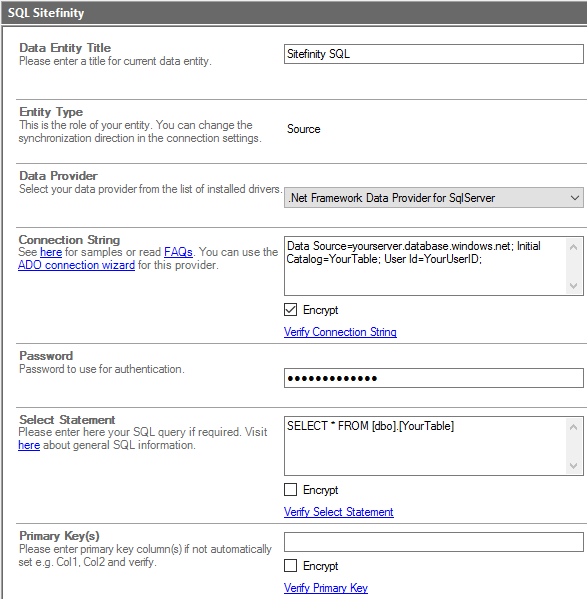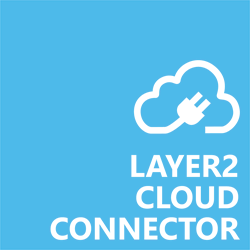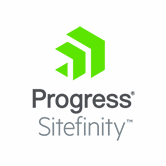Keep your SharePoint in sync. Download and try today.
Sitefinity Data Integration and Synchronization
Sitefinity is a Web Content Management System (WCMS) and Digital Marketing Platform used to create and manage corporate websites. It can be codelessly connected to 150+ systems and apps via the Layer2 Cloud Connector to keep pre-selected data in sync, one-way or even two-way.
To connect to Sitefinity the data source entity must be configured as follows in the Layer2 Cloud Connector Connection Manager:

Fig.: Example connection configuration to connect to Sitefinity.
Sitefinity Specific Configuration Settings
Please note the following Sitefinity specific settings:
- Select the .Net Framework Data Provider for SqlServer to connect.
- You can use a connection string like this to connect:
Data Source=yourserver.database.windows.net; Initial Catalog=YourTable; User Id=YourUserID; - Make sure that you can reach the database from where you are running the Layer2 connector.
- You can map your data fields to specific external source fields in the Layer2 Cloud Connector. Please take care about data types (simple type conversions are supported).
- No installation or changes are required at the data source or data destination.
- You can make use of all SQL queries your data provider supports. You can also use stored procedures that returns records, exec myStoredProcedure().
- The primary key is normally set automatically, if available.
- You can use the connection for uni- or bi-directional synchronization. Several replication conflict solution strategies are offered.
- No need to open your local network for access from outside.
- Bi-directional sync is generally supported. You query must be updatable for this (note that most joins are not). You will also need write access rights for this.
Sitefinity Data Integration Scenarios
Generally all types of tables / content types in Sitefinity can be connected. Sitefinity data integration is especially helpful in case of Sitefinity tables that are related to web forms, such as contacts, feedback, or registrations.
- Push new entries from Sitefinity contact forms to backend IT systems for any further processing.
- Connect Sitefinity to collobaration systems like Microsoft SharePoint / Office 365 to start workflows on user interaction.
- Connect to Microsoft Teams or Office Groups to keep your team informed about customer interactions.
- Connect and sync with your existing CRM, such as Salesforce or Microsoft Dynamics to define follow-ups.
- Integrate with Microsoft Flow or Azure Logic Apps for scalable cloud-based cross-platform processing.
- Connect to local SQL databases for archiving, or reporting.
- You will find 150+ more systems to connect to Sitefinity here.
Sitefinity Data Integration - Known Issues and Workarounds
- Generally no programming required to setup a connection. But programming is possible for data cleanup, transformation, or translation between the connected systems via Dynamic Columns in C#.
- No need to modify the connected systems.
- No need to open your local network for access from outside.But you have to make sure that you can connect to the Sitefinity database remotely, or run the Layer2 Cloud Connector just there (if possible).
- Generally, there are also other options to connect to Sitefinity using the Odata interface.
- For more detailed setting options please take a look at the Layer2 Cloud Connector User's Guide.
Ready for the next steps?




